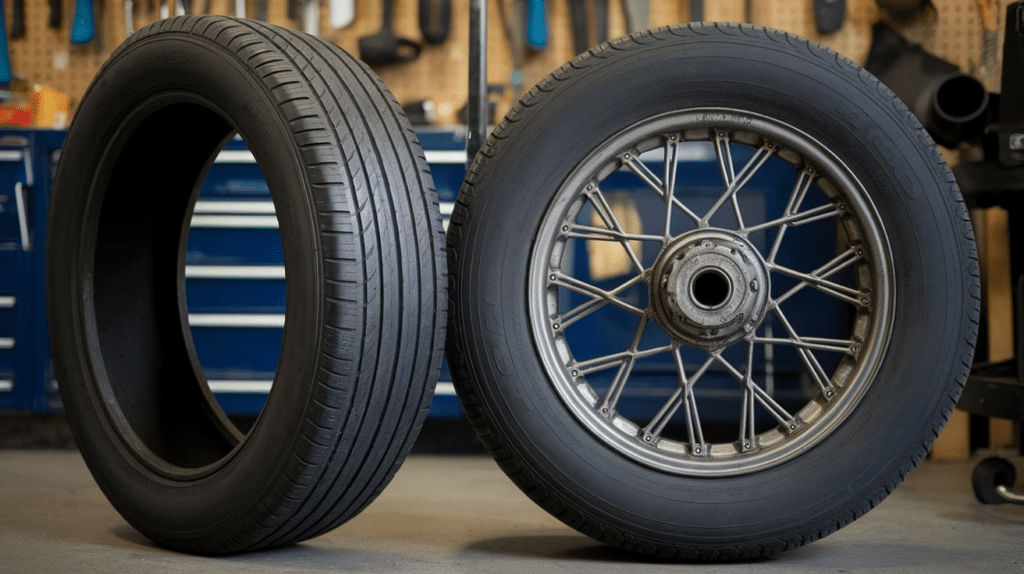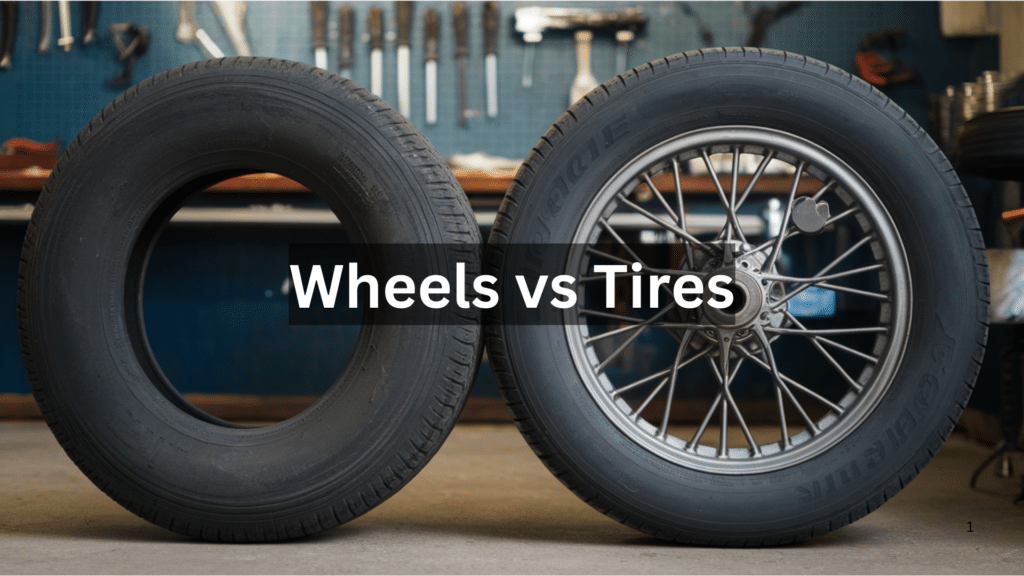Are you confused about the wheels and tires on your truck? You’re not alone. Many truck owners mix up these important parts, but understanding the difference is crucial for proper maintenance.
In this guide, I’ll explain:
- The key differences between wheels and tires
- What each part does for your truck
- How to choose the right ones
- When to replace them
My 15 years working with trucks have taught me what matters most for safety and performance. Whether you are a new truck owner or need a refresher, this article will solve your confusion.
The difference between wheels and tires isn’t just technical talk – it affects how your truck drives, how safe you are on the road, and how much money you’ll spend on repairs.
Let’s get this sorted out right now.
Are Tires and Wheels The Same Thing?

No, tires and wheels are definitely not the same thing.
The wheel is the metal part that attaches to your truck’s axle. The tire is the rubber part that wraps around the wheel.
Think of it like this: your shoe (the tire) goes on your foot (the wheel). They work together but serve different purposes.
Wheels provide structure and support. They’re typically made of steel or aluminum alloy.
Tires provide traction and cushioning. They’re made of rubber compounds designed for specific driving conditions.
Without good wheels and tires, your truck won’t go anywhere. That’s why understanding the difference matters so much for truck owners like you.
The Basic Functions of Wheels and Tires
What Wheels Do
- Support the weight of your truck
- Connect to the axle and braking system
- Provide a mounting surface for tires
- Add style to your vehicle
What Tires Do
- Grip the road surface
- Absorb shocks and bumps
- Provide traction in different weather conditions
- Create the contact point between your truck and the road
Your wheels provide structure, while your tires provide performance. Both must work perfectly together for a safe ride.
Think about it this way: The best tires in the world won’t help if mounted on damaged wheels. And expensive, fancy wheels are useless with worn-out tires.
Breaking Down the Anatomy of Wheels
Wheels might look simple, but they’re more than metal circles holding tires. Understanding the basic parts of a wheel helps you pick better replacements and maintain them easily.
Here’s what makes up a typical truck wheel:
- Rim – The outer edge that holds the tire
- Disc/Center – The middle section that connects to your truck
- Hub – The center hole where the wheel mounts to the axle
- Lug holes – Where the lug nuts secure the wheel
- Valve stem hole – Where air goes in
Wheels come in different materials. Steel wheels are tough and cheap. Alloy wheels are lighter and look better. Carbon fiber wheels are super light but very expensive.
Your truck’s wheels’ size, width, and offset affect its handling. Bigger isn’t always better!
Bad wheels can cause:
- Vibration while driving
- Uneven tire wear
- Poor handling
- Even accidents in extreme cases
The Intricacies of Tire Components
Tires look simple, but there’s more going on than meets the eye. Each part plays a role in how your car handles and stays safe. Cut open a tire, and you’ll find it’s way more complex than it looks.
A modern tire has several important parts:
- Tread – The rubber pattern that contacts the road
- Sidewall – The side section with all the tire information
- Bead – The edge that seals against the wheel
- Plies – Internal fabric layers that give the tire strength
- Belts – Usually made of steel, they reinforce the tread area
The rubber compound matters, too. Summer tires use softer rubber for better grip, and winter tires use special compounds that stay flexible in cold weather.
Did you know? Those numbers on your sidewall tell you the tire’s size, load rating, and speed rating. Learning to read this code helps you choose the right replacements.
Example: P265/70R17 115T
- P = Passenger vehicle tire
- 265 = Width in millimeters
- 70 = Aspect ratio (sidewall height as percentage of width)
- R = Radial construction
- 17 = Wheel diameter in inches
- 115 = Load index
- T = Speed rating
Selecting the Right Wheels and Tires for Your Truck
Picking your truck’s right wheels and tires isn’t just about looks. I’ve found the right choice can make driving safer and smoother. Here’s how you can easily select what’s best for your truck.
Consider:
For Wheels
- Correct diameter for your truck
- Proper width for your desired tires
- Weight rating that matches your needs
- Finish that suits your style and environment
For Tires
- All-terrain for mixed driving
- Highways for mostly pavement
- Mud-terrain for serious off-road use
- Season-appropriate tread patterns
Your driving habits matter most. A heavy-duty work truck needs different wheels and tires than a weekend off-roader.
Remember: Bigger wheels usually mean less sidewall on your tires. This looks cool but can make your ride harsher.
Check your truck’s owner’s manual for the recommended wheel and tire specifications. Going too far from factory specs can affect your truck’s performance and safety.
How Do I Know When My Wheels and Tires Need to Be Replaced?
Knowing when to replace your wheels and tires keeps you safe. I’ve learned to spot the signs early, saving me stress and money. Here’s how you can tell if it’s time for a change.
You need new tires when:
- Tread depth is less than 2/32 of an inch (use the penny test!)
- You see cracks or bulges in the sidewall
- Your tires vibrate excessively
- Uneven wear patterns appear
Your wheels need attention when:
- You notice bends or cracks
- They no longer hold air properly
- They cause vibration even with new tires
- You see corrosion that won’t clean off
Don’t wait until you have a blowout or accident. Regular inspections save lives!
The penny test is simple: Insert a penny into your tire’s tread with Lincoln’s head upside down. If you can see all of Lincoln’s head, your tread is too worn, and you need new tires.
Most trucks need tire rotation every 5,000-7,000 miles to ensure even wear. Mark this on your maintenance calendar!
Conclusion
Now you understand the key differences between wheels and tires. These two components work together but serve distinct purposes for your truck.
Wheels provide the structural support your vehicle needs, while tires deliver the crucial road contact that keeps you moving safely.
Regular inspection of both parts is essential. Don’t wait for problems to become obvious – it might be too late by then.
Your truck’s performance depends on these components working perfectly together. When one fails, the other can’t compensate.
Remember: Your wheels and tires are the only things between your truck and the road. Invest in quality parts, maintain them properly, and replace them when needed. Your safety is worth it.
Frequently Asked Questions
How Often Should I Rotate My Tires?
Every 5,000-7,000 miles for most trucks, but check your owner’s manual for your specific vehicle’s recommendation.
Can I Mix Different Tire Brands on My Truck?
It’s not recommended. Different brands have different handling characteristics that can affect your truck’s stability and safety.
Do I Need Special Wheels for Off-Roading?
Yes, off-road wheels are typically stronger and designed to handle impacts better than standard street wheels.
What’s Better: Larger Wheels or More Tire Sidewall?
It depends on your needs. A smoother ride and better off-road performance are the benefits of more sidewalls, while larger wheels improve on-road handling and appearance.
How Do I Know What Size Wheels Fit My Truck?
Check your owner’s manual or look for the tire information sticker in your door jamb. This information tells you the recommended wheel and tire sizes.


